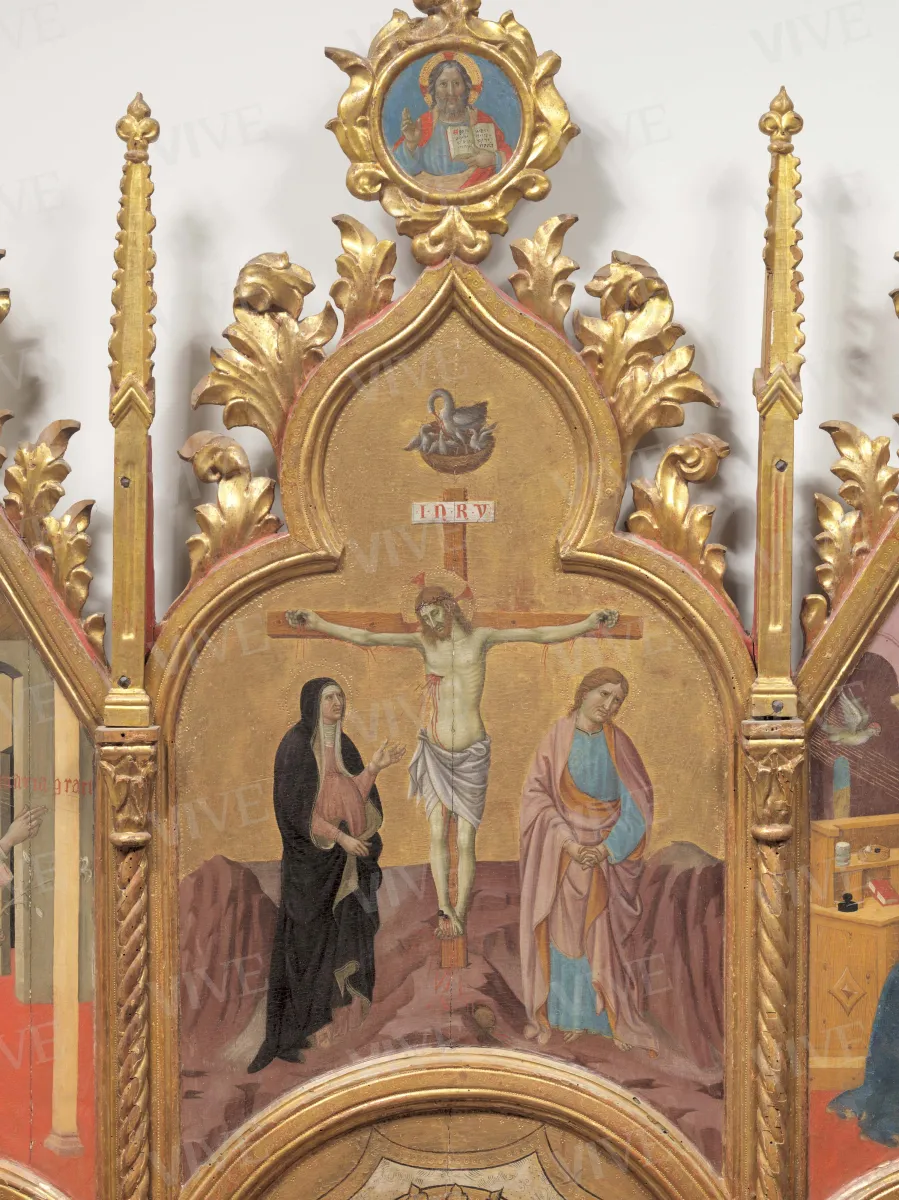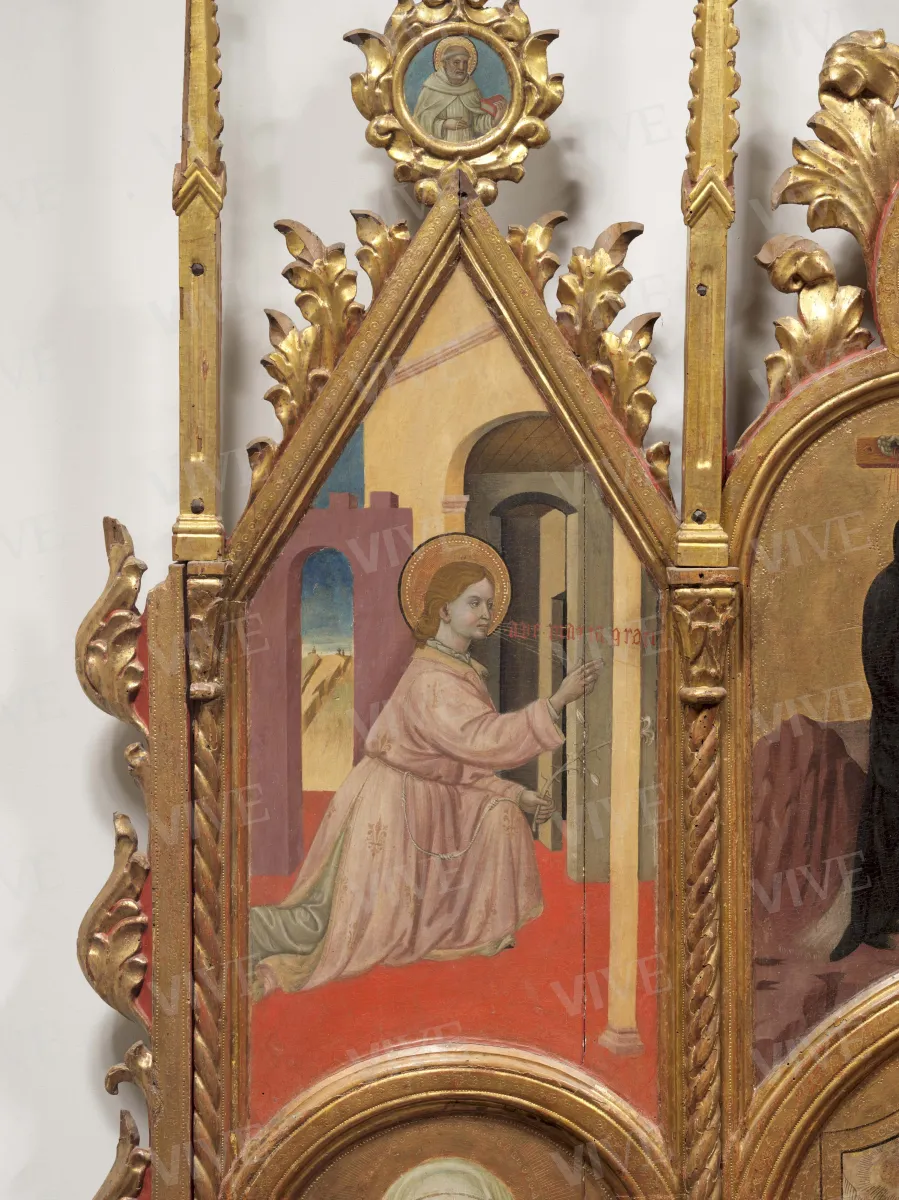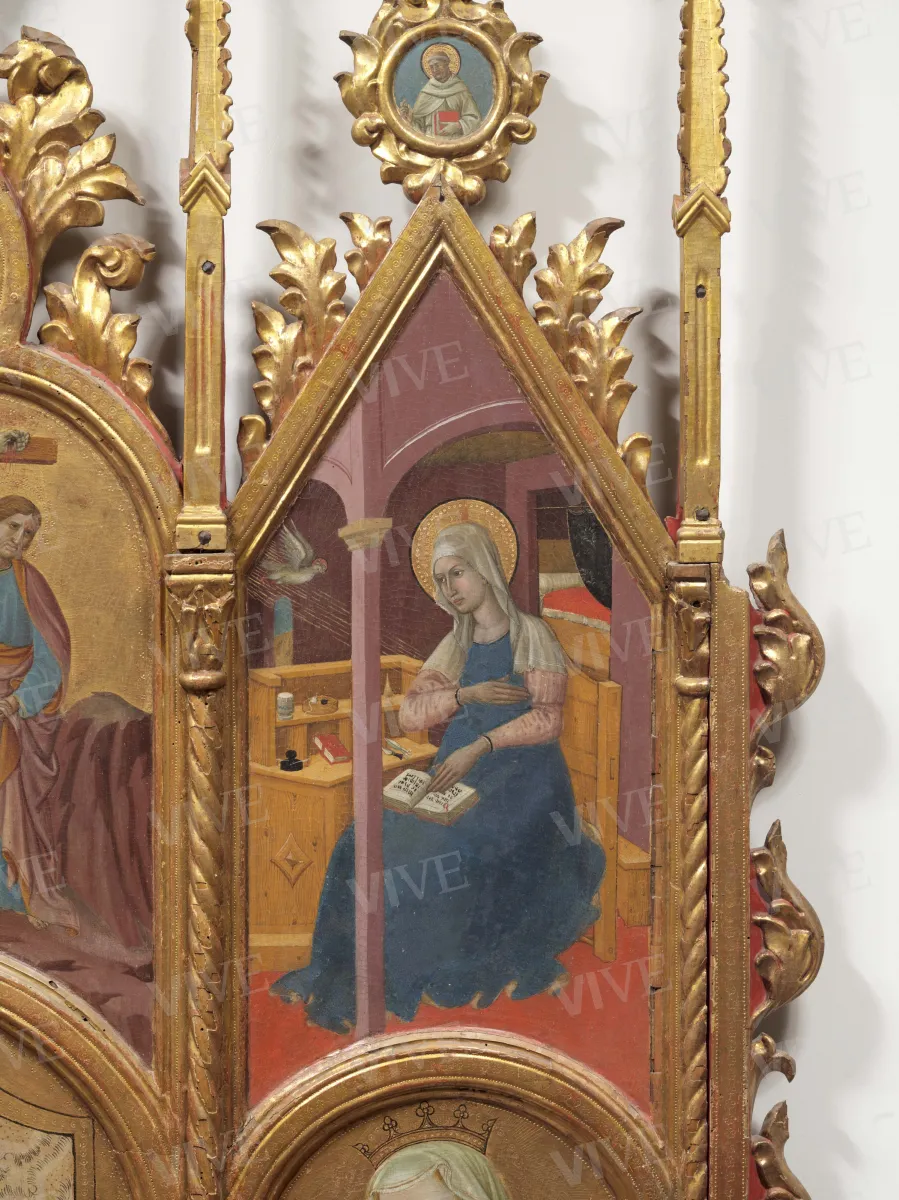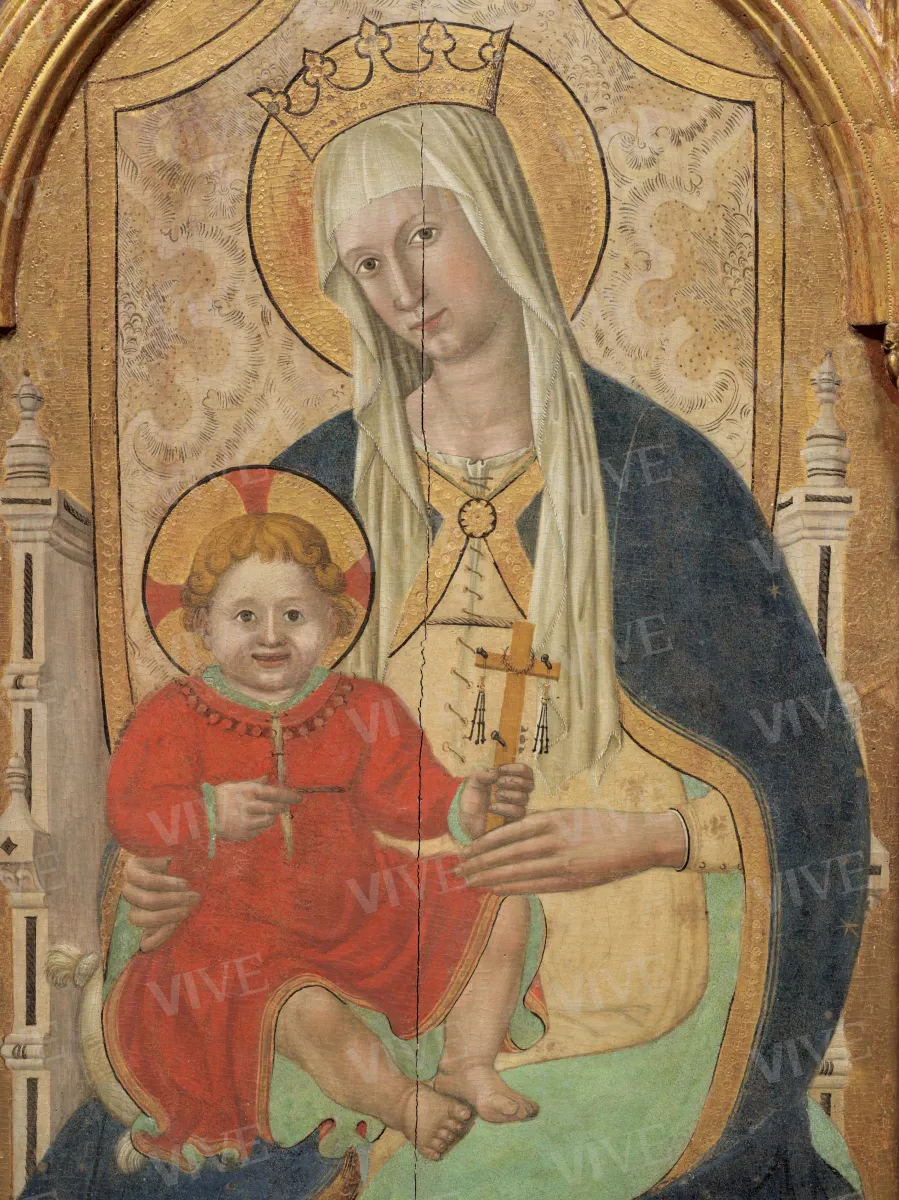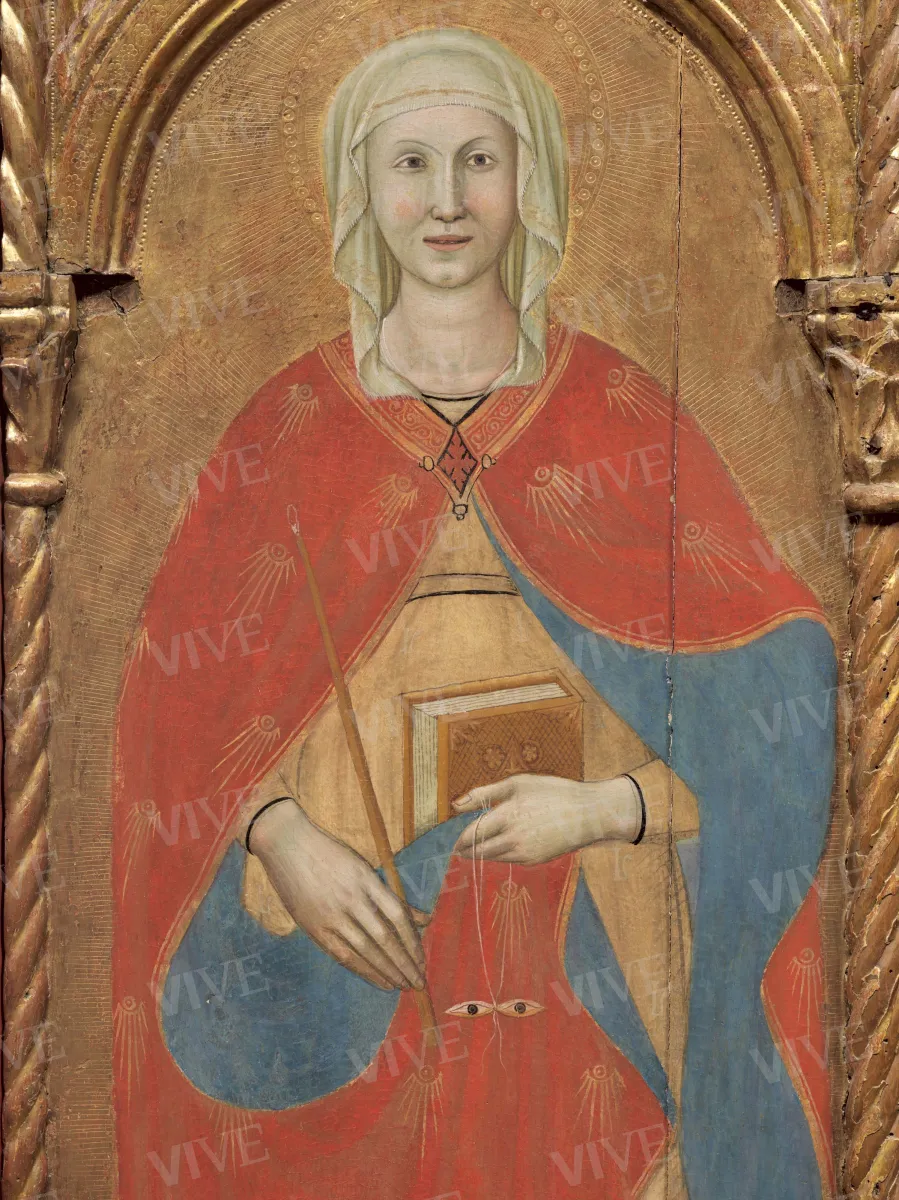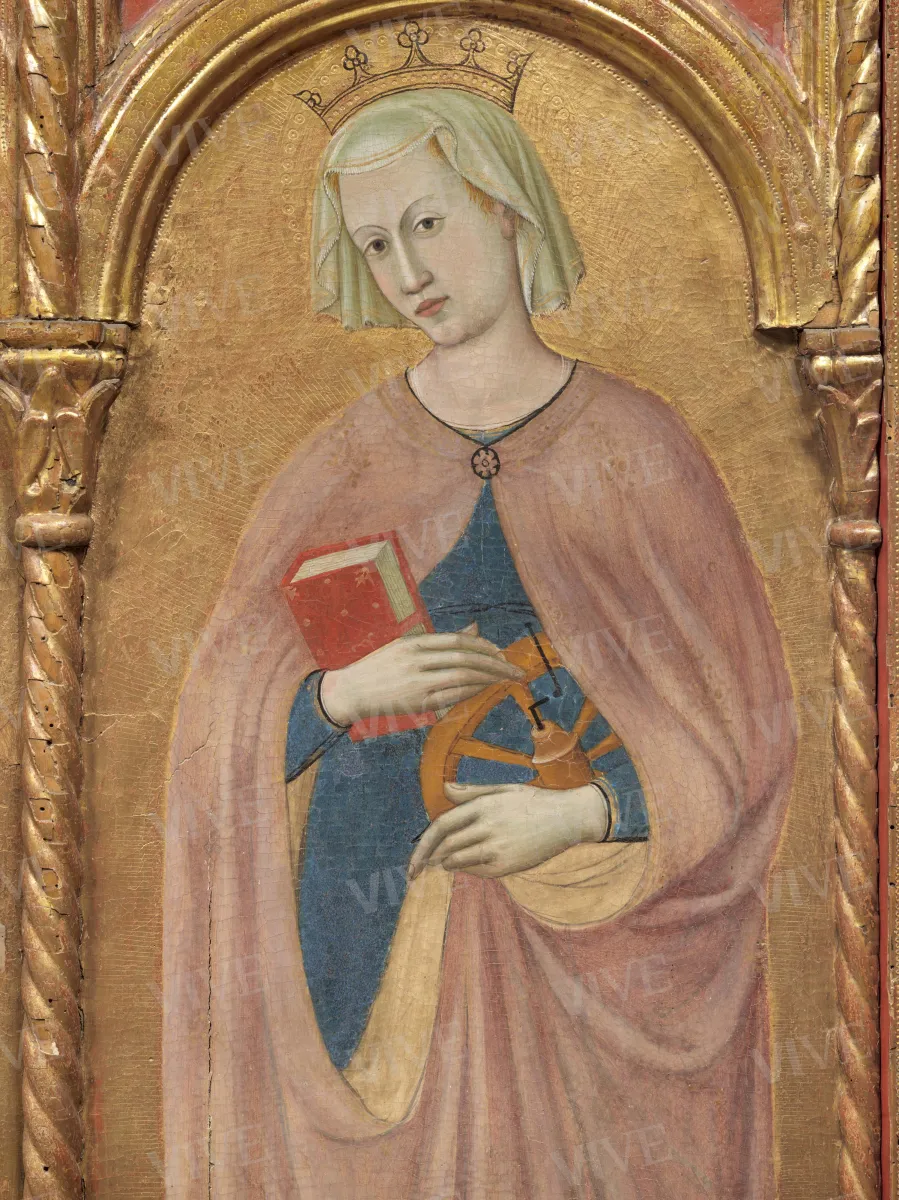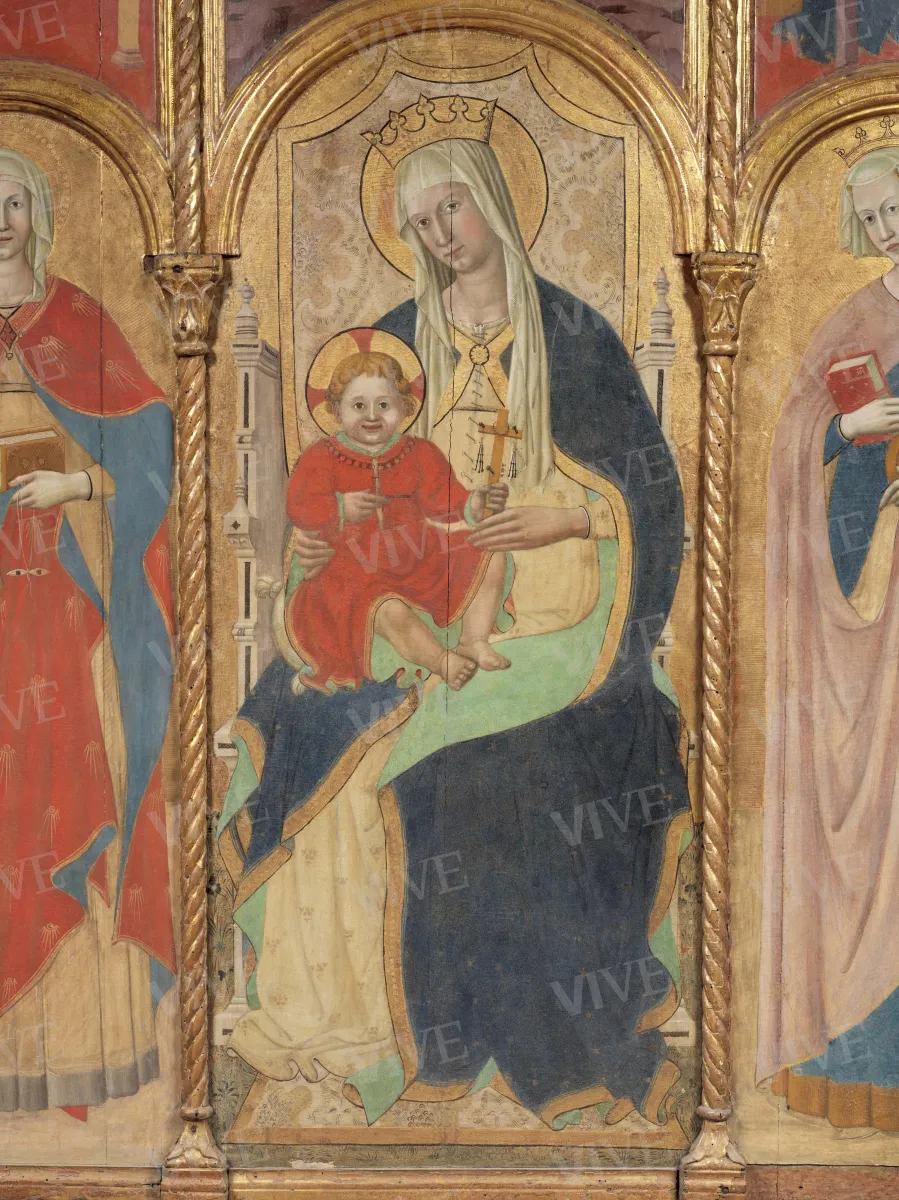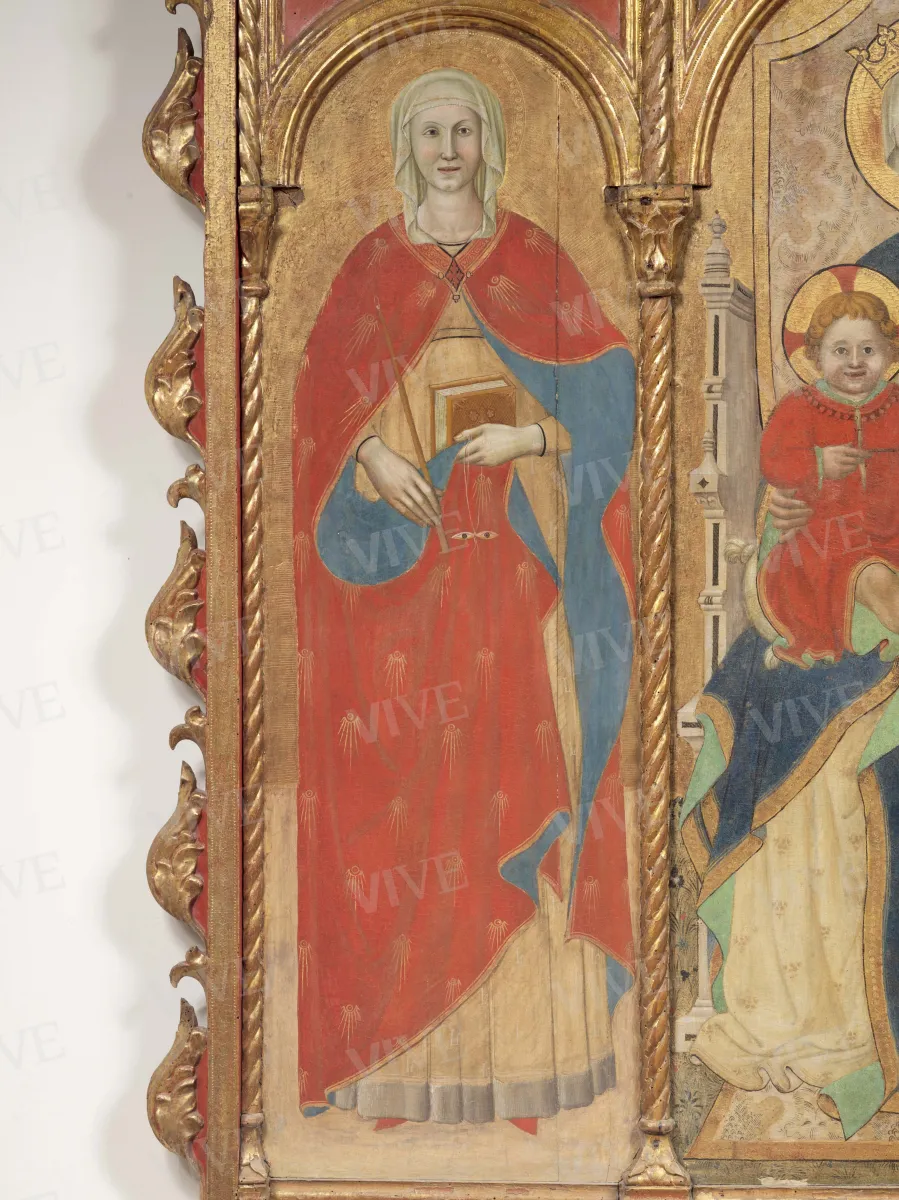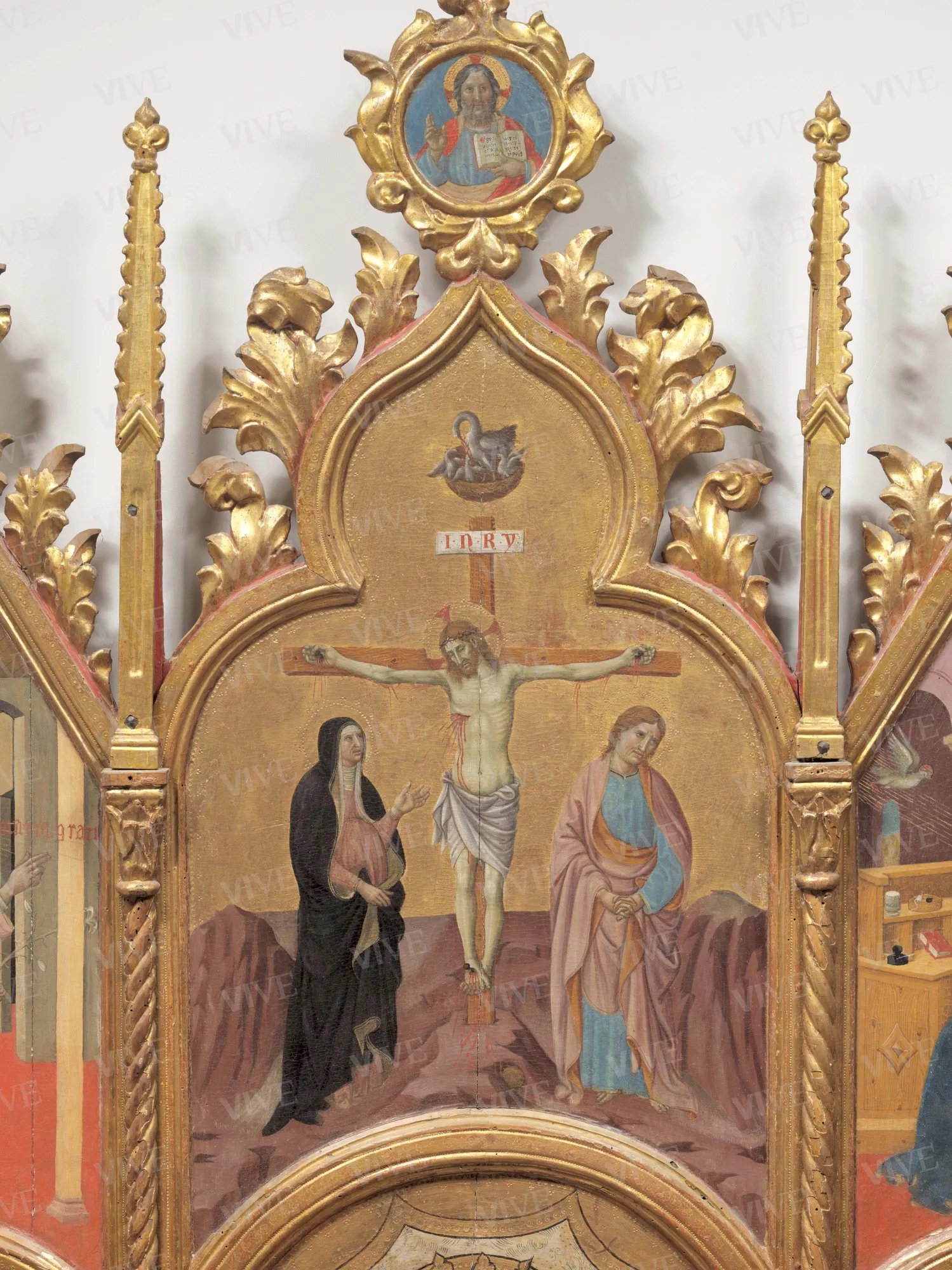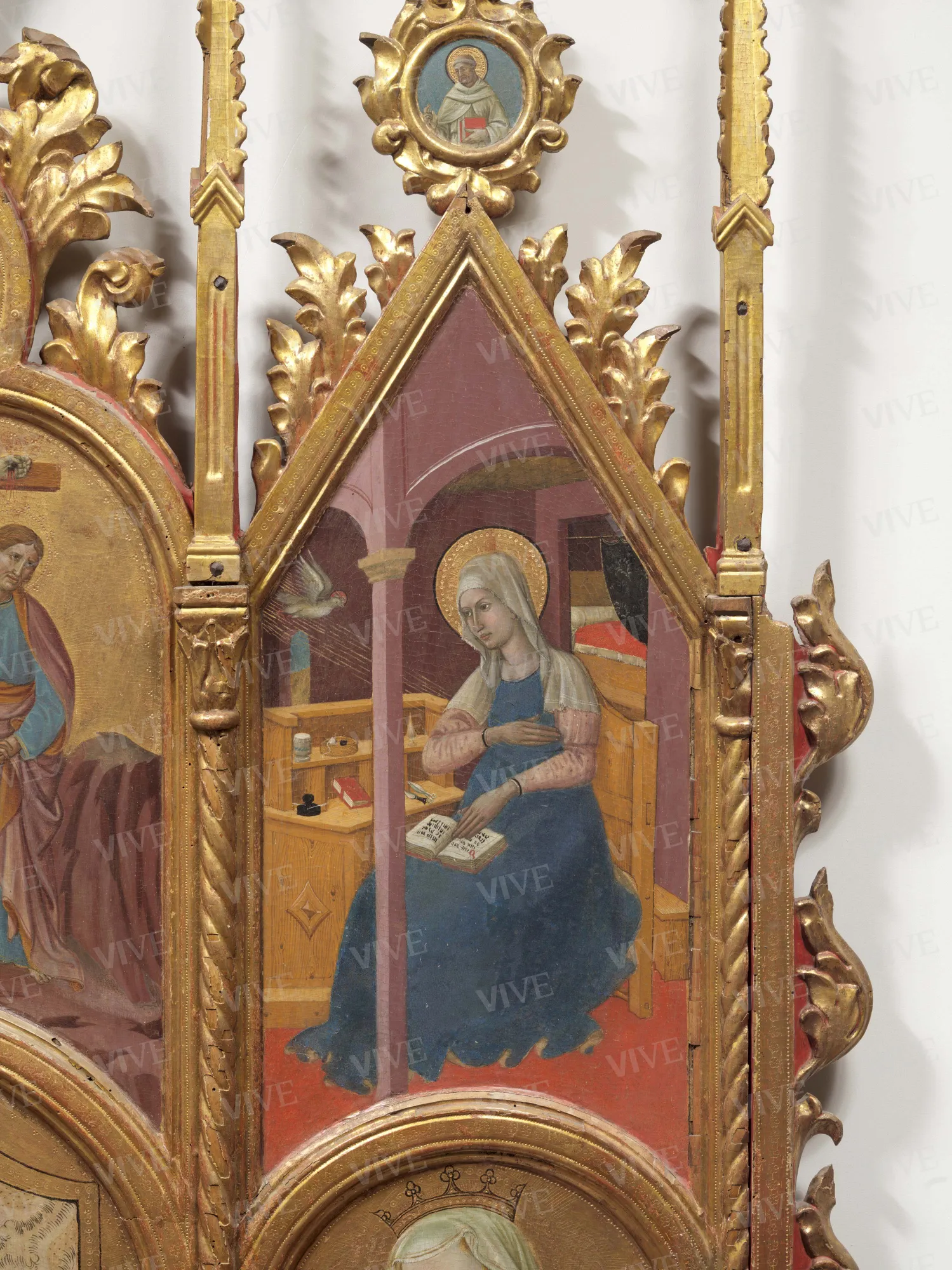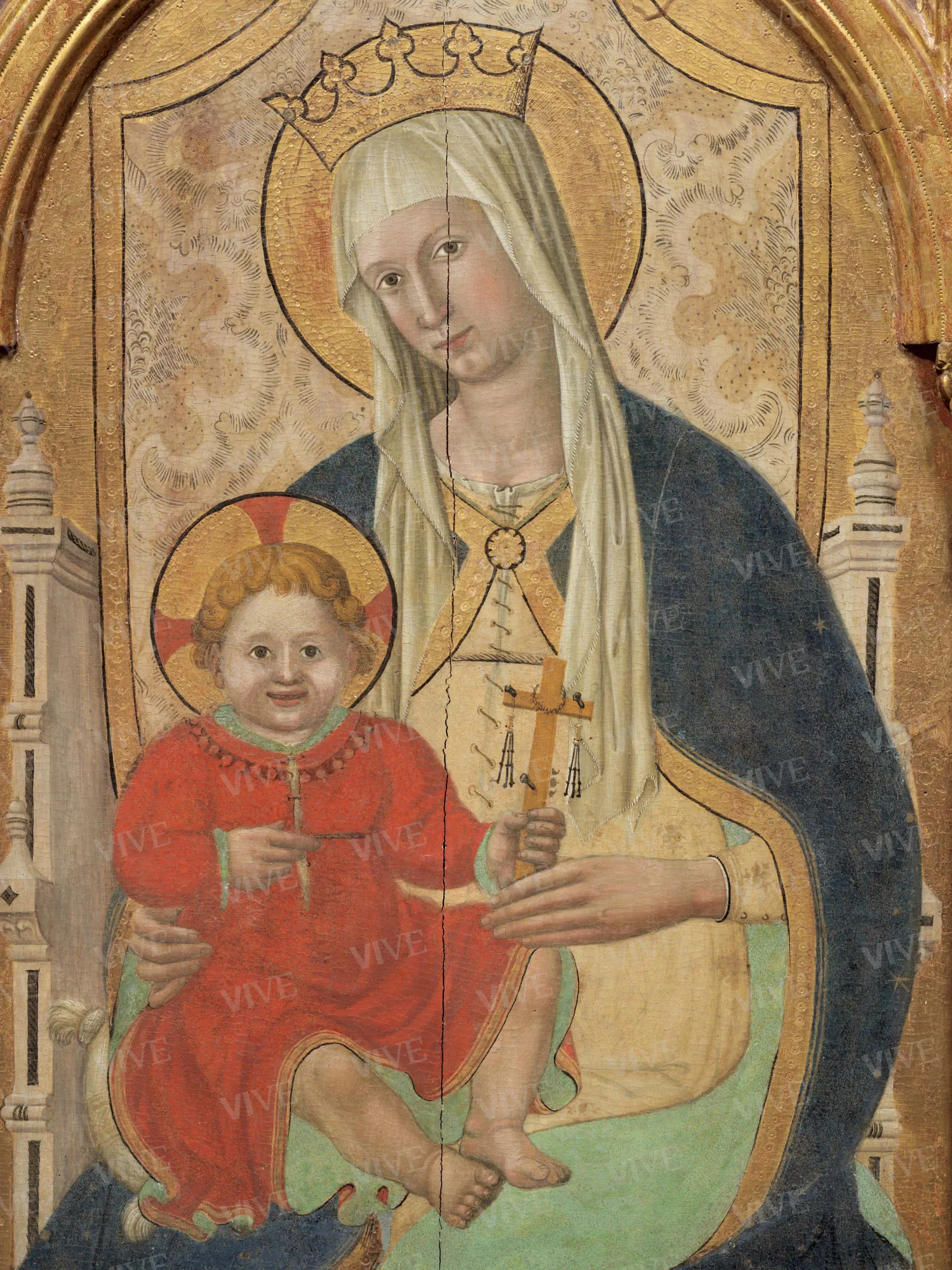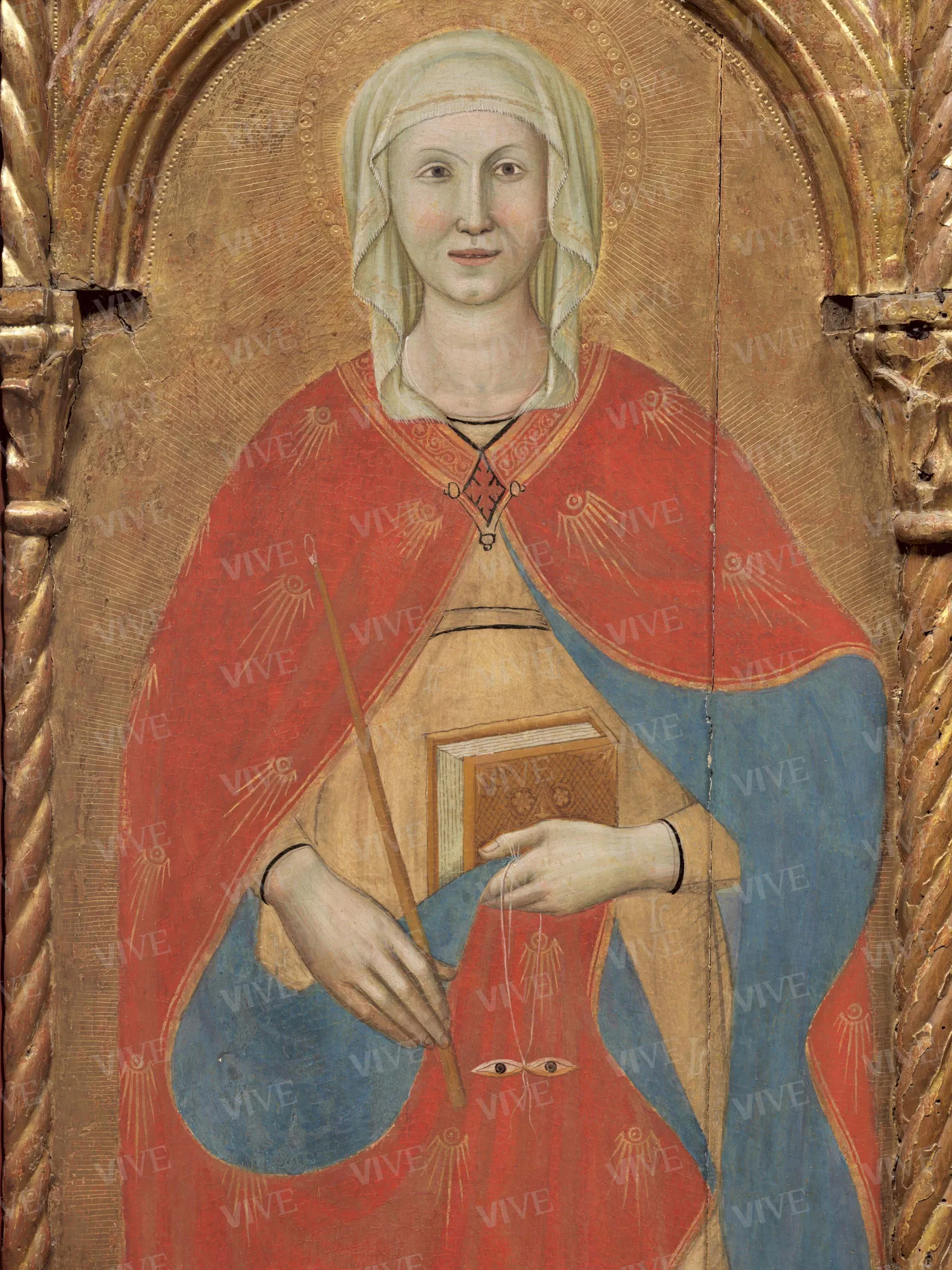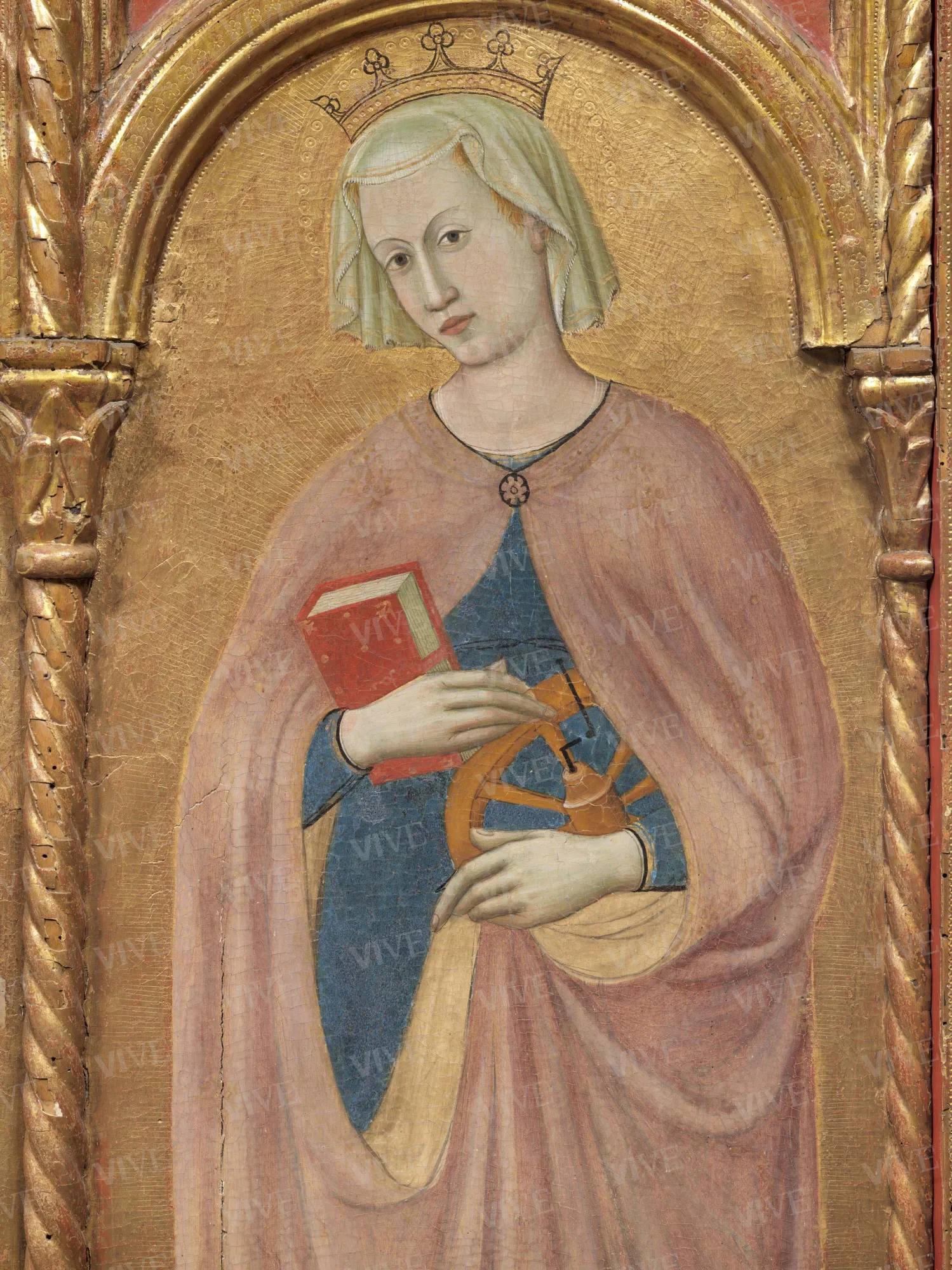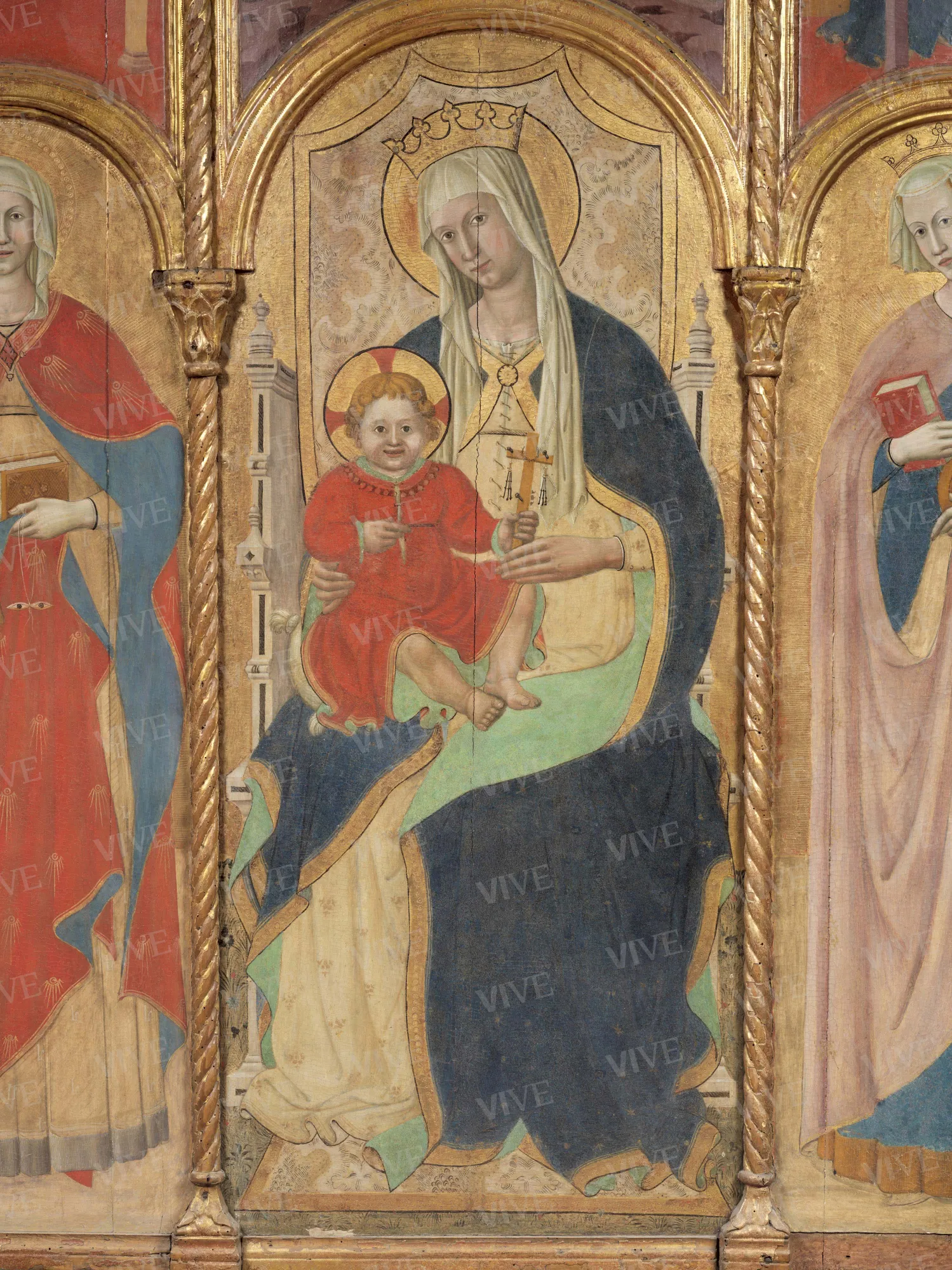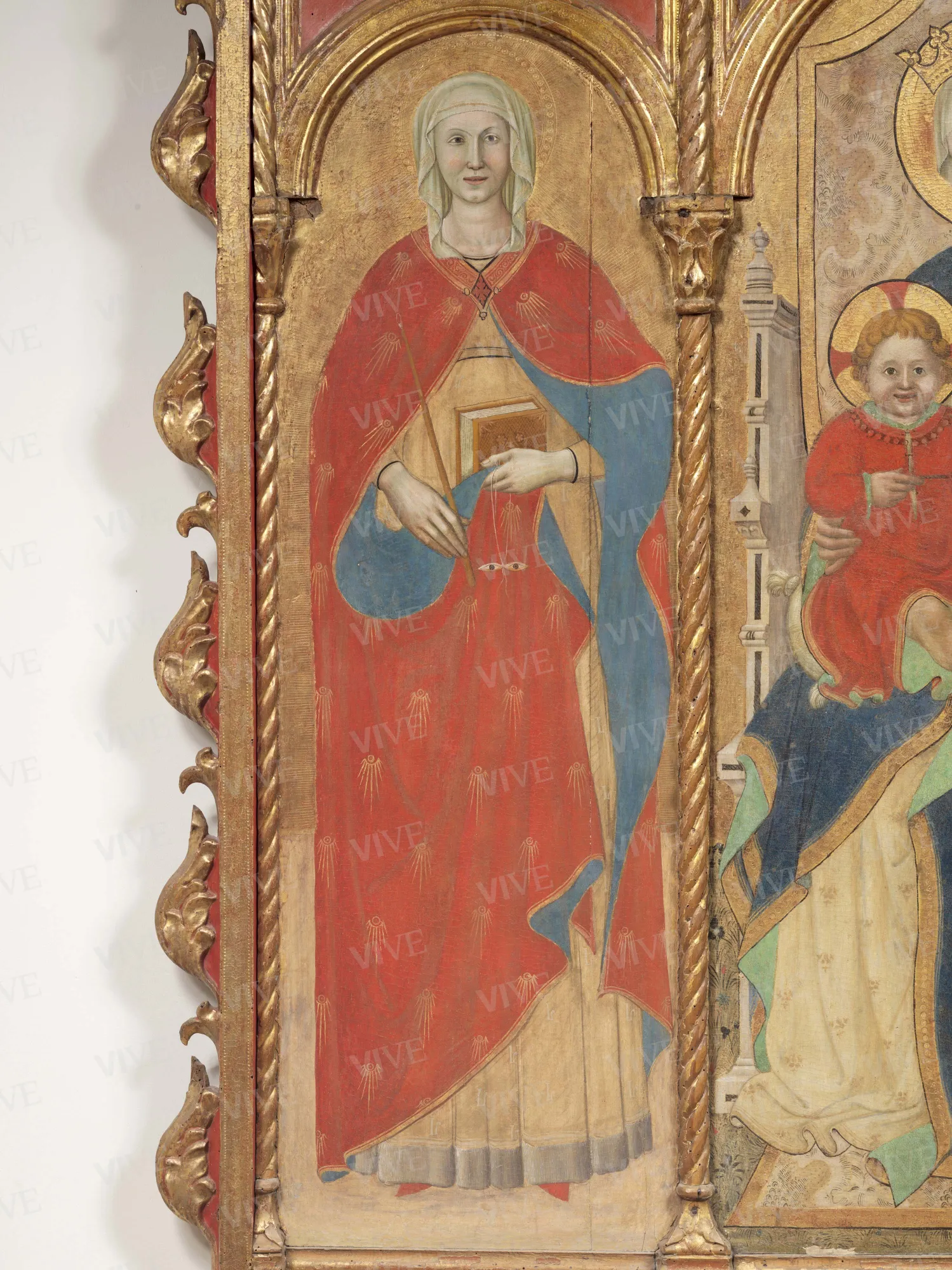Madonna and Child with the Instruments of the Passion, between Saint Lucy and Saint Catherine of Alexandria; Annunciation; God the Father Blessing, Blessed Gherardo of Serra de’ Conti, and Blessed Alberto of Sassoferrato.
Giovanni Antonio Bellinzoni da Pesaro C. 1470
The triptych is a later work by Giovanni Antonio Bellinzoni da Pesaro, who was part of the last late-Gothic wave in the Marches region. It has recently been identified as originally belonging to the church of Santa Lucia in Serra de’ Conti, a dependency of the Benedictine abbey of Santa Croce di Sassoferrato, which accounts for its unique iconography. The wooden structure of the triptych is well-preserved, though it is missing the predella, offering insight into the original appearance of many similar works that have been altered over time.
The triptych is a later work by Giovanni Antonio Bellinzoni da Pesaro, who was part of the last late-Gothic wave in the Marches region. It has recently been identified as originally belonging to the church of Santa Lucia in Serra de’ Conti, a dependency of the Benedictine abbey of Santa Croce di Sassoferrato, which accounts for its unique iconography. The wooden structure of the triptych is well-preserved, though it is missing the predella, offering insight into the original appearance of many similar works that have been altered over time.
Details of work
Catalog entry
The triptych is presented in its entirety with its original frame, characterized by extensive decorative elements on the moldings, including six-petal roses along the uprights and arches, and simple circles on the upper register and lower edge. This makes it a rare example of well-preserved Gothic carpentry. In the main register, beneath three round arches, the central image depicts the Madonna and Child Enthroned. Notably, Jesus holds a cross with instruments of the Passion in his left hand while indicating this depiction with his right hand. Saints Lucy and Catherine of Alexandria flank him; Saint Lucy is identifiable by her attributes of the candle and her gouged-out eyes, while Saint Catherine is marked by her princely crown, book, and the wheel used in an attempt to torture her. The upper order contains varied frames, with triangular cusps at the sides and trilobate arches in the middle, separated by pinnacles. The central compartment features the Crucifixion, with the three main figures set against a barren rocky landscape, while the Annunciation is depicted on both sides, in an architectural scenario unusual for the painter. At the top, there are three tondos surrounded by leafy decorations similar to those on other parts of the altarpiece: the central one depicts God the Father blessing with an open book, while the others show two holy monks in white robes, bearded and holding books. Gold leaf is extensively used, worked with a punch and engraved, bordered in black in multiple details (hems of robes, crowns, halos in the main compartment, Annunciation, and terminal clypei); the dense rays engraved on the golden background around the saints' figures contribute to enhancing luminous reverberations.
The triptych was unknown to scholars until 1955, when it was purchased by the State. At the same time, it was recognized as the work of its true author in a brief article that announced the acquisition (Anonimo 1955). Subsequently, its provenance was traced back to the church of Santa Lucia in Serra de’ Conti, located in the province of Ancona (Villani 2007). Before 1880, it belonged to Count Girolamo Possenti di Fabriano (1768–1843) and was sold in Florence that year. The origin of the triptych accounts for the prominence given to Saint Lucy, the martyr of Syracuse, positioned to the right of the Virgin’s throne (to the left from the observer’s viewpoint), and aids in identifying the two white monks painted in the tondos as Blessed Gherardo da Serra de’ Conti and Alberto da Sassoferrato, who are also depicted by Bellinzoni in the polyptych of Santa Croce di Sassoferrato. Santa Lucia was dependent on a Benedictine abbey, which sent a rector there. The presence of the two local saints is likely a reference to the mother house (Minardi 2019). The detail of the cross in the hands of the Baby Jesus probably alludes to the title of the abbey church. The commission of the triptych can be linked to a news item from 1470, when Gabriele di Niccolò da Sassoferrato, the rector of Santa Lucia, sold some land to finance work on the building. This date is in keeping with stylistic evidence indicating a work from the final years of Giovanni Antonio da Pesaro, characterized by increasingly wooden figures (inv. 10225 for a biographical profile of the painter). This suggests that the painter’s Gothic training was adapting to the modernized art scene in the Marches region. A recent study (Moretti 2022) confirmed the provenance and recovered a document from 1602 mentioning a predella with Apostles that was then removed. It has been proposed to identify this predella with one of which five fragments are known (four pairs of Apostles and a blessing Christ) preserved in various private collections. To these known pieces, a sixth, previously unpublished piece should be added, which features Saints Bartholomew and Jude Thaddaeus, documented in the Roberto Longhi photo library in Florence (Roberto Longhi Art History Study Foundation, no. 70226). For the same church in Serra de’ Conti, Bellinzoni created a two-sided banner, now divided into two faces (Madonna and Child Enthroned and Crucifixion) and displayed in the Galleria Nazionale delle Marche. This banner came from the church of the Confraternita del Santissimo Sacramento (confraternity of the Blessed Sacrament ) but was originally made for the association’s original headquarters, Santa Lucia. This is supported by the depiction of Saint Lucia at the foot of the Crucifix (Minardi 2019).
Matteo Mazzalupi
Entry published on 27 March 2025
State of conservation
Excellent.
Inscriptions
In the compartment of the announcing Angel, painted in red: “ave maria grati(a plena)”;
in the cartouche at the top of the cross, painted in red: “INRY.”
Provenance
Serra de’ Conti, church of Santa Lucia, before 1880;
Fabriano, Count Girolamo Possenti, before 1880;
Florence, Impresa di Vendite Raffaele Dura, sale of the collection of Count Girolamo Possenti, April 1–10, 1880, lot 643;
Rome, Collezione Barsanti, until 1955;
purchased by the Italian State, 1955.
References
Catalogue d’objets d’art et de curiosité formant la collection de feu M.r le Comte Girolamo Possenti de Fabriano, Rome 1880, lotto 643, p. 61;
Anselmi Anselmo, Miscellanea storico-artistica di Sassoferrato e dintorni. Nuovi studi e indagini archivistiche, 1885-1905, Firenze 1905, p. 8;
Anonimo, Acquisti dei Musei e Gallerie dello Stato (1955). Giovanni Antonio da Pesaro: "trittico", in «Bollettino d’arte», IV, 1955, pp. 370-371;
Berardi Paride, Giovanni Antonio Bellinzoni da Pesaro, Fano 1988, pp. 142-144;
Minardi, in Costanzi Costanza (a cura di), Le Marche disperse. Repertorio d’arte dalle Marche al mondo, Cinisello Balsamo 2005, p. 123, n. 59;
Bomprezzi, in Villani Virginio, Le chiese di Serra de’ Conti. Arte, storia e devozione religiosa, Ostra Vetere 2007, pp. 168-169, n. 4;
Villani Virginio (a cura di), Le chiese di Serra de’ Conti. Arte, storia e devozione religiosa, Ostra Vetere 2007, pp. 127-128, 147-150;
Marchi Alessandro, La Crocifissione di Polverigi. Giovanni Antonio da Pesaro nella Marca d’Ancona, in De Marchi Andrea, Mazzalupi Matteo (a cura di), Pittori ad Ancona nel Quattrocento, Milano 2008, pp. 210-223;
Minardi Mauro, Tre questioni interferenti l’abbazia di Santa Croce a Sassoferrato, da Giovanni Antonio da Pesaro a Pietro Paolo Agabiti, in «Arte marchigiana», 7, 2019, pp. 11-43;
Moretti Massimo, Non solo Crivelli. Nuovi documenti dell’Archivio Graziani sul trittico di Giovanni Antonio da Pesaro per Santa Lucia a Serra de’ Conti, in De Luca Daphne, Papetti Stefano, Roselli Graziella, Di Girolami Giuseppe (a cura di), Opus Karoli Crivelli. Le opere e la materia. Nuove letture su Carlo Crivelli, Atti delle giornate di studi (Ascoli Piceno, 22-23 ottobre 2021), Ascoli Piceno 2022, pp. 161-174.


